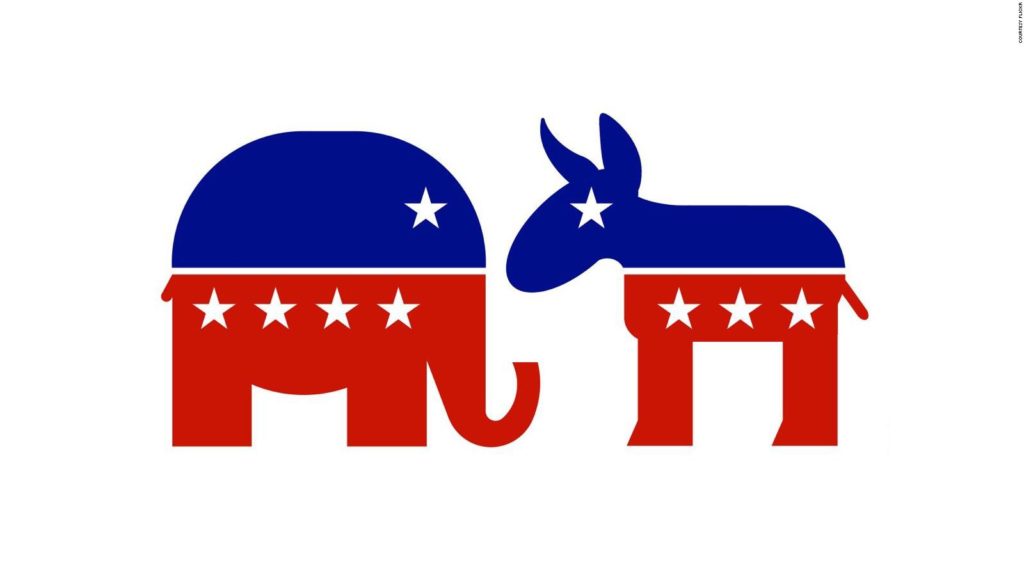Table of Contents
FACTUAL ELECTIONS
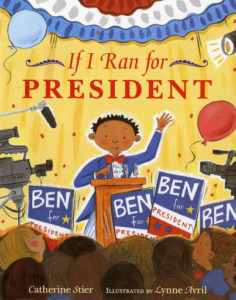
|
Catherine Stier’s If I Ran for President (Albert Whitman & Company, 2007) is a nicely done introduction in which six multiracial kids take turns explaining the ins and outs of the election process, from the initial decision to run, through campaigns, primaries, conventions, debates, voting, and the ultimate decision of the electoral college, ending with the inaugural address. For ages 5-9. |
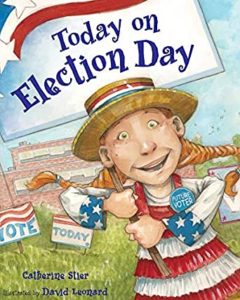
|
Also by Stier, Today on Election Day (Albert Whitman & Company, 2012), provides information about the election process through a fictional story about a class election day. |
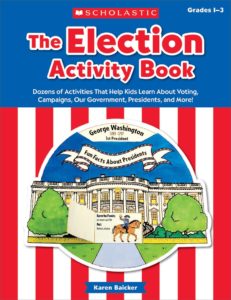
|
Karen Balcker’s 32-page Election Activity Book (Scholastic Teaching Resources, 2012) has dozens of projects, games, and activities on campaigns, elections, and presidents. For example, kids make an election timeline, conduct opinion polls, design political ads, and make a presidential fact wheel. For ages 6-8. |
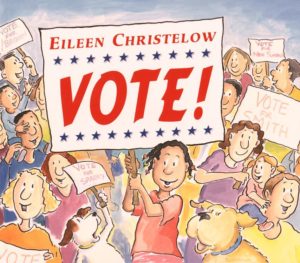
|
Eileen Christelow’s Vote! (Clarion Books, 2008) uses the election of a new mayor as a jumping-off point for a discussion of the history of voting rights, the nature of political parties, and the campaign and voting process, with a lot of humorous illustrations and comments by the mayoral candidate’s two very involved dogs, Elmer and Sparky. A great choice for ages 7-10. |
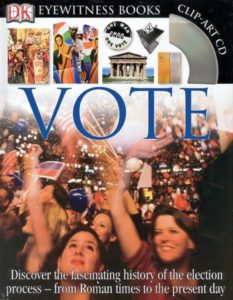
|
Vote in the popular DK Eyewitness series (Dorling Kindersley Publishing, 2008) is a visually appealing history of the election process, lushly illustrated with photos of artifacts and reproductions of prints and paintings. Each double-page spread covers a different topic, among them “Democratic roots,” “The first parliaments,” “Slaves or citizens?” “Power to the workers,” “Votes for women,” “How elections work,” and “Protest!” Also included are world facts and figures, a timeline of democracy, and an “A to Z of famous people.” For ages 8-12. |
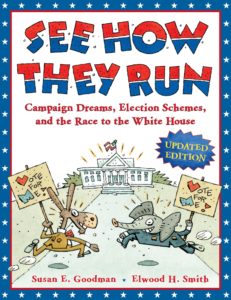
|
See How They Run: Campaign Dreams, Election Schemes, and the Race to the White House by Susan E. Goodman (Bloomsbury USA, 2008) is a 96-page history of elections from the beginnings of democracy in ancient Greece to the modern-day electoral college, spattered with witty anecdotes, fact sidebars, quotations, photos, illustrations, and clear explanations. Readers learn all the basics, plus get the scoop on mudslinging, assassinations, and Andrew Jackson’s over-the-top inauguration party that wreaked havoc with the White House chairs. For ages 9-13. |
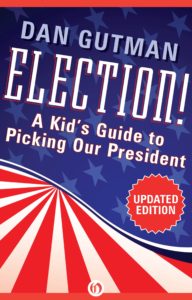
|
Jaded adults may not agree with the introductory description of a presidential campaign (“It’s like one big yearlong party”), but Dan Gutman’s Election! A Kid’s Guide to Picking Our President (Open Road Young Readers, 2012), written in a catchy question-and-answer format, is an excellent overview of presidential elections for ages 9-12. Sample questions include “Why do we have a president?” “Is the president the boss of the United States?” and “What’s the difference between a Democrat and a Republican?” For ages 9 and up. |
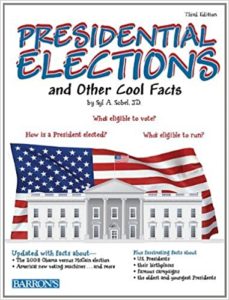
|
In similar question-and-answer format see Syl Sobel’s Presidential Elections and Other Cool Facts (Barron’s Educational Series, 2012). |
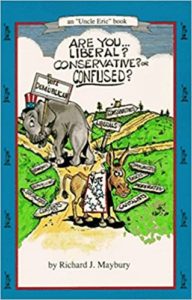
|
Richard J. Maybury’s Are You Liberal? Conservative? Or Confused? (Bluestocking Press, 2004), written as a series of helpful letters from the savvy Uncle Eric to his politically confused niece/nephew Chris, endeavors to define such essential terms as liberal, conservative, left, and right, and to put them in historical perspective. Maybury is opinionated and readers may not always agree with his views, but he’s a guaranteed discussion-starter. For ages 11 and up. |
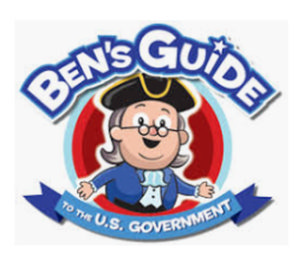 |
At Ben’s Guide to the U.S. Government for Kids, Ben is a cartoon Benjamin Franklin who provides grade-specific general information on the process of electing the president, vice president, senators, and representatives. Explanations are provided at three different levels, for grades 3-5, 6-8, and 9-12. |
 |
From the Library of Congress, Elections…the American Way is an excellent historical overview of presidential elections, illustrated with period photographs. Topics covered include Candidates, Voters (“Who can vote? How has this changed over time?”), the Party System, the Election Process, and Campaign Issues. See the Candidates page (click on “Gallery”) for a project in which kids make their own slate of presidential candidates in the form of dried-apple dolls. |
| From Duke University, America Votes is a fascinating collection of historical campaign memorabilia, everything from buttons, songs, and trading cards, to inflammatory leaflets and bumper stickers. Included are images, interesting explanations, and links to historical presidential campaigns and political parties. | |
| Election Scavenger Hunt is a project in which kids scour the newspapers for informational articles, photographs, and cartoons about the opposing candidates. Adaptable for a wide range of ages. | |
 |
From the Smithsonian in Your Classroom, Winning the Vote: How Americans Elect Their President is a collection of interactive lesson plans on the presidency, political parties, and presidential campaigns. Included at the website are instructions, discussion questions and printable illustrated worksheets. |
| Presidential Elections covers all in order, starting with George Washington. |
PRESIDENTS
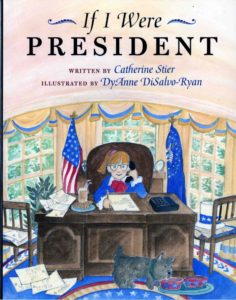
|
Catherine Stier’s If I Were President (Albert Whitman & Company, 1999), explains the duties (and perks) of the president through the eyes of a presidential kid, wearing a blue jacket and red bowtie. “If I were president, I’d start work early each morning in the Oval Office…If I were president, each year I’d give a speech to Congress called the State of the Union…If I were president, one of my favorite jobs would be passing out medals to people who had done brave deeds.” For ages 4-8. |
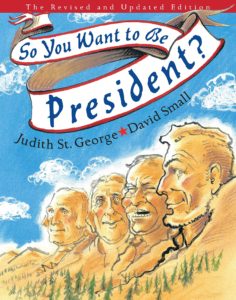
|
Judith St. George’s So You Want to Be President? (Philomel Books, 2004), a creative picture-book overview of presidents and the presidency, begins with the good and bad aspects of the office. Good: You get to live in the White House, with your own swimming pool, bowling alley, and movie theater. Bad: You have to be dressed up all the time. (William McKinley, St. George tells us, decked himself out daily in a frock coat, satin tie, gloves, and top hat.)
A collective portrait of presidents in labeled T-shirts is a gallery of presidential first names: six Jameses, four Johns, four Williams, three Georges, two Andrews, and two Franklins. Many presidents had pets (Benjamin Harrison kept a goat); some were musical (Jefferson played the violin; John Quincy Adams, the flute; Warren Harding, the sousaphone); and several had unconventional educations. (Nine presidents never went to college; and Andrew Johnson didn’t learn to read until he was fourteen). An appendix lists the presidents in chronological order, with brief statements of crucial events of their administrations. For ages 6-10. |
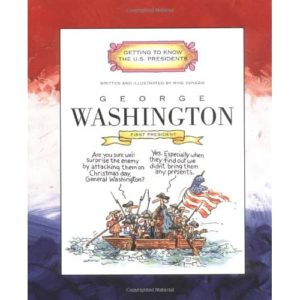 |
Mike Venezia’s Getting to Know the U.S. Presidents series (Children’s Press) is a collection of clever 32-page biographies of every president from (so far) George Washington to George W. Bush, each illustrated with photos, period prints, and clever cartoon asides. For ages 5-9. |
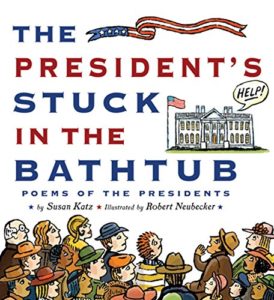
|
Susan Katz’s The President’s Stuck in the Bathtub (Clarion Books, 2012) is a collection of 43 funny and fact-filled illustrated poems, one for each president (so far), beginning with “Where Didn’t George Washington Sleep?” (Everywhere except the White House.) For ages 6-9. |
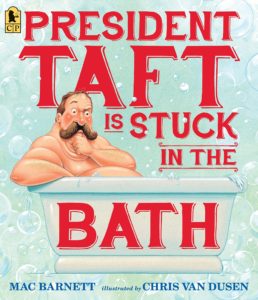 |
Also see Mac Barnett’s President Taft is Stuck in the Bath (Candlewick, 2016). (“Blast!” said Taft. “This could be bad.”) For ages 4-8. |
| For more on the particularly plump President Taft, see William Howard Taft is Still Stuck in the Tub. |
|
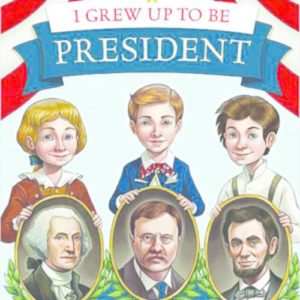
|
Laurie Calkhoven’s I Grew Up to Be President (Scholastic Paperbacks, 2011) is a nicely designed introduction to the presidents from Washington to Obama, with a colorful pair of pages devoted to each, covering childhood, career, notable accomplishments, and unusual facts. Short sections at the end explain the three branches of government and the process of presidential elections. For ages 7-11. |
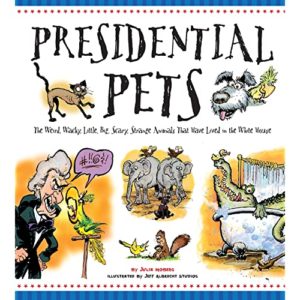
|
Julia Moberg’s Presidential Pets (Charlesbridge, 2012) provides bulleted lists of catchy information (Presidential Stats, Tell Me More, and Accomplishments & Events) on all the presidents and their pets – which included, along with a lot of conventional dogs and cats, John Quincy Adams’s alligator, Thomas Jefferson’s bear cubs, Martin Van Buren’s tigers, Teddy Roosevelt’s zebra, and Woodrow Wilson’s sheep. A drawback: each president/pet is introduced with an awkward little poem. For ages 7-11. |
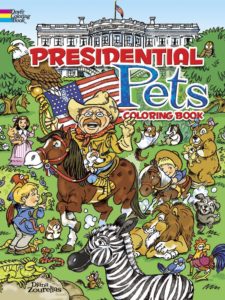 |
Like to color? Diana Zourelias’s Presidential Pets Coloring Book (Dover Publications, 2009) has black-line drawings of 30 presidents and their conglomerations of pets, each with a short informative paragraph. (Calvin Coolidge kept chickens in the bathtub.) |
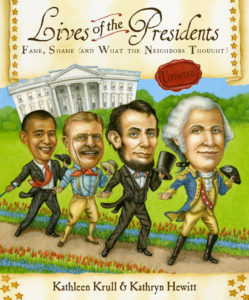
|
Kathleen Krull’s Lives of the Presidents: Fame, Shame, (and What the Neighbors Thought) (Harcourt Children’s Books, 2011) is a talented, terrific, and highly readable collection of 42 presidential biographies, filled with human interest, and illustrated with (giant-headed) portraits by Kathryn Hewitt. Highly recommended for ages 8 and up. |
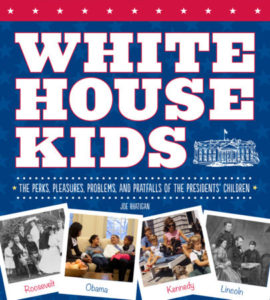
|
Joe Rhatigan’s White House Kids (Imagine Publishing, 2012) is a creatively designed 96-page history of presidents’ children, illustrated with photos, paintings, and period prints. Included are short first-person accounts of their experiences by the kids themselves and intriguing fact boxes with titles like “What Did the Jackson White House Kids Get for Christmas?” For ages 7-12. |
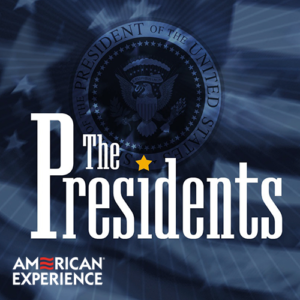 |
PBS’s The Presidents series covers them all in individual episodes, from George Washington to Bill Clinton. At the website, click on each president for primary source material, images, and film clips. |
